We Leap into March with a Lunar X, the Evening Moon Slides by Several Star Clusters, Venus near Uranus, and Betelgeuse Brightens!

The Open cluster Messier 35, also known as the Shoe-Buckle cluster sits near the feet of Castor in Gemini. The small open cluster NGC 2158 is to the lower right of it in this image from the Sloan Digital Sky Survey. The area of sky shown here measures about one finger’s width of the sky, side-to-side. Messier 35 is visible in binoculars and backyard telescopes.
Hello, March Stargazers!
Here are your Astronomy Skylights for the week of March 1st, 2020 by Chris Vaughan. Feel free to send me your comments, questions, and suggested topics. You can also follow me on Twitter as @astrogeoguy! Unless otherwise noted, all times are expressed in Eastern Time. To receive Skylights by email, please click this MailChimp link.
I can bring my Digital Starlab portable inflatable planetarium to your school or other daytime or evening event. Contact me through AstroGeo.ca, and we’ll tour the Universe together!
The moon will feature an X on Sunday night. Then it will travel through the big Winter Hexagon, and also slide close to some nice star clusters while it shines in the evening sky the world over. Venus, the brilliant “Evening Star” will continue its appearance in the western sky, passing quite close to Uranus on the weekend. The star Betelgeuse has started to brighten. Meanwhile, early risers can enjoy the planetary manoeuvrings of Mars, Jupiter, Saturn, and Mercury in the pre-dawn southeast. Here are your Skylights!
Leaping into March
Yesterday (Saturday) was February 29th, better known as Leap Day! We add an extra day to February once every four years in order to keep our calendar from drifting. Here’s why. A year is defined as the time taken for a planet to orbit precisely once around the sun. In Earth’s case, that takes 365.2425 days (call it 365¼ days) – and each of our four seasons commences when Earth reaches one of four particular spots in its orbit, roughly every three months.
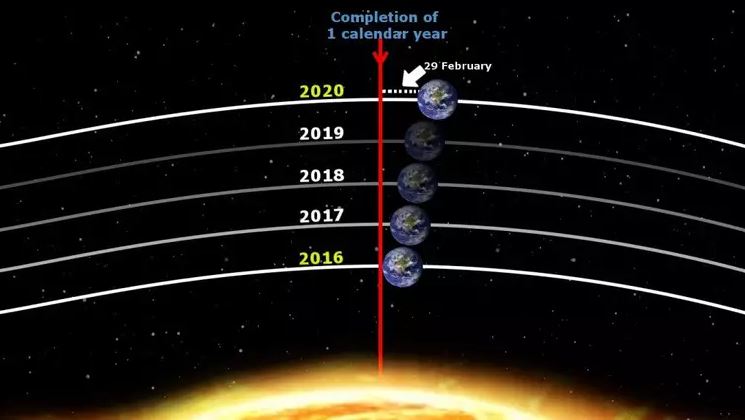
That extra quarter of a day, if not taken care of, would eventually cause dates to occur when the Earth has travelled much farther along its orbit. In four years, it’s roughly a day’s worth. After a few hundred years, summer weather would be arriving when the calendar on the wall says it’s March. The dates for Easter, Passover, and the Chinese and Persian New Year festivals would move around the calendar, too. For example, Easter always occurs on the Sunday following the first Full Moon after the Vernal Equinox (i.e, the first day of spring in the Northern Hemisphere).
Ancient people knew about the issue – so Julius Caesar created a calendar that added a leap day every four years, inserting the first Leap Day in the year 8 AD. But by 1582, the calendar had still become out of step by 10 days! Why? Because our year is actually about 11 minutes and 14 seconds short of exactly 365¼ days. So Pope Gregory implemented the Gregorian Calendar, fixing the error by deleting the ten days from October 4 through 15, 1582, and also refining the system of leap days. Henceforth, to keep everything correct, we don’t add a Leap Day in years that are divisible by 100, unless the year is divisible by 400. So the year 2000 was a leap year and 2100 will not be. All of these gyrations keep us on track.
Future residents of Mars, if they adopt a Martian calendar, will have more frequent leap days than we do because a Mars year is 668.5991 Martian days in length. That will require adding three leap days every five years. Maybe they’ll use them as a bonus long weekend to celebrating the first human on the Red Planet!
An X on the Moon
Several times a year, for a few hours near its first quarter phase, a feature on the moon called the Lunar X becomes visible in strong binoculars and backyard telescopes. When the rims of the craters Parbach, la Caille, and Blanchinus are illuminated from a particular angle of sunlight, they form a small, but very obvious X-shape. The phenomenon called is pareidolia – the tendency of the human mind to see familiar objects when looking at random patterns. The Lunar X is located just to the right (or lunar east) of the pole-to-pole terminator boundary that divides the lit and dark hemispheres on the moon. The X is about one third of the way up from the southern pole of the Moon at lunar coordinates 2° East, 24° South. The prominent round crater Werner sits to the lower right of the X.
Tonight, Sunday, March 1, the Lunar X is predicted to peak in intensity at 6:52 pm EST (or 23:52 GMT) – but the phenomenon will be visible for approximately two hours on either side of that time. This event will be visible across large portions of the Earth – wherever the moon is shining in a dark sky during that time window. To know when to look, simply adjust for your difference from the Greenwich Time zone. For the Great Lakes region, the Moon will be positioned high in the southwestern sky.
The Moon and Planets
The moon will reach its first quarter phase on Monday at 2:57 pm EST. At first quarter, the relative positions of the Earth, sun, and moon cause us to see the moon half illuminated – on its western (right-hand) side. First quarter moons always rise at noon and set at midnight, so they are visible starting in the afternoon hours. The term first quarter refers not to the moon’s appearance, but the fact that our natural satellite has now completed the first quarter of its orbit around Earth, counting from the last new moon.
The first half of this week will be a fine time to view the moon in your binoculars or backyard telescopes. The moon will already be high in the sky at sunset, so youngsters with early bed times can share in the fun. The sunlight striking the moon along the pole-to-pole terminator line that separates the lit and dark hemispheres will be arriving at a shallow angle – nearly horizontally – so the topography along that zone will be thrown into stark relief. The moon has no atmosphere to scatter light – so the shadows on it are extra dark. The Illumination changes every night – and even hour by hour – so take every opportunity to enjoy our beautiful natural satellite.

After the sky has darkened tonight (Sunday), look for the nearly half-illuminated moon sitting below the stars of Taurus (the Bull). The pretty little Pleiades star cluster will be positioned a generous palm’s width to the moon’s upper right. (That’s 7° to the celestial north.) The stars that create the triangular face of the bull, and the bright, orange, foreground star Aldebaran, will be located to the moon’s upper left. That triangle of stars is a nearby star cluster known as the Hyades. By the time the moon sets at 1 am in your local time zone, the moon’s orbital motion will have carried it between the Pleiades and the Hyades – or, even above them – if you live in western North America or the Pacific Ocean region.
For the rest of the week, the moon will set later and wax fuller each night. On Tuesday, the moon will depart Taurus and enter Gemini (the Twins), the constellation above Orion (the Hunter). If you point binoculars at the sky four finger widths above (or 4° to the celestial northeast of) the moon, you should see a fuzzy clump of stars known as Messier 35, or the Shoe-Buckle Cluster. That star cluster contains more than 100 stars covering an area about the size of the moon. It is located 2,800 light-years away from us! The brighter stars above the moon are the feet of Castor, Gemini’s more westerly twin.

The moon will travel through the rest of Gemini on Wednesday and Thursday. In the southeastern sky after dusk on Friday evening, March 6, the bright moon will be positioned less than two finger widths to the lower left (or 1.75 degrees to the celestial east) of the large open star cluster known as the Beehive Cluster or Messier 44. It’s in the constellation of Cancer (the Crab), although the crab’s stars will be too dim to see with unaided eyes.
At only 577 light-years from us, Messier 44 is one of the closest star clusters to Earth. It contains about 95 stars within a circular measuring three times the moon’s diameter. The moon passes close to, or through, this cluster frequently because the Beehive is located only a finger’s width north of the ecliptic. To see the cluster’s stars, try placing the bright moon just outside the field of view of your binoculars. As the night wears on, the moon will move farther away from the cluster, and the rotation of the sky will raise the moon to the cluster’s upper left.
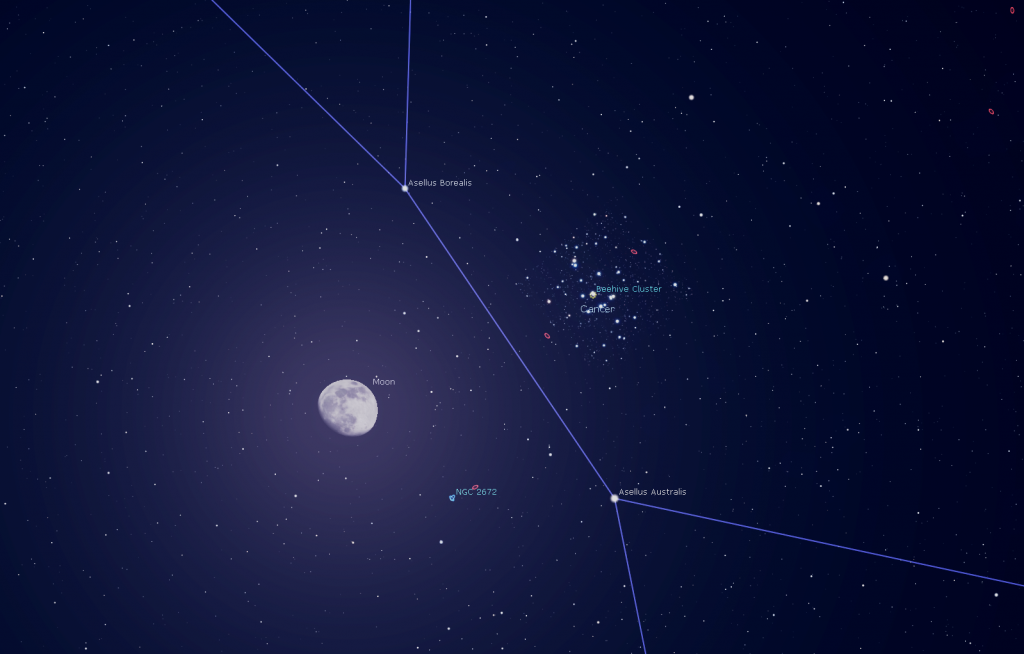
On the coming weekend, the moon will grow to almost full and pass into the spring constellation of Leo (the Lion) in the eastern evening sky. The bright star to the moon’s right will be Regulus, also known as Alpha Leonis. It represents the lion’s heart.
Not counting the moon, the most dominant object in the evening sky this week will be Venus. Our sister planet will gleam at a spectacular magnitude of -4.35 in the western evening sky from before dusk until it sets before midnight in your local time zone. (The more negative the magnitude value, the brighter an object looks.)
Until March 24, Venus will continue to climb higher in the sky – and farther from the sun. If you want to see Venus’ less-than-fully-illuminated disk in your telescope, train your telescope on it as soon as you can pick it out of the darkening sky. In a twilit sky, Venus’ brightness won’t hide its shape as much. And, when Venus is higher in the sky you’ll be viewing the planet more clearly – through less of Earth’s distorting atmosphere.
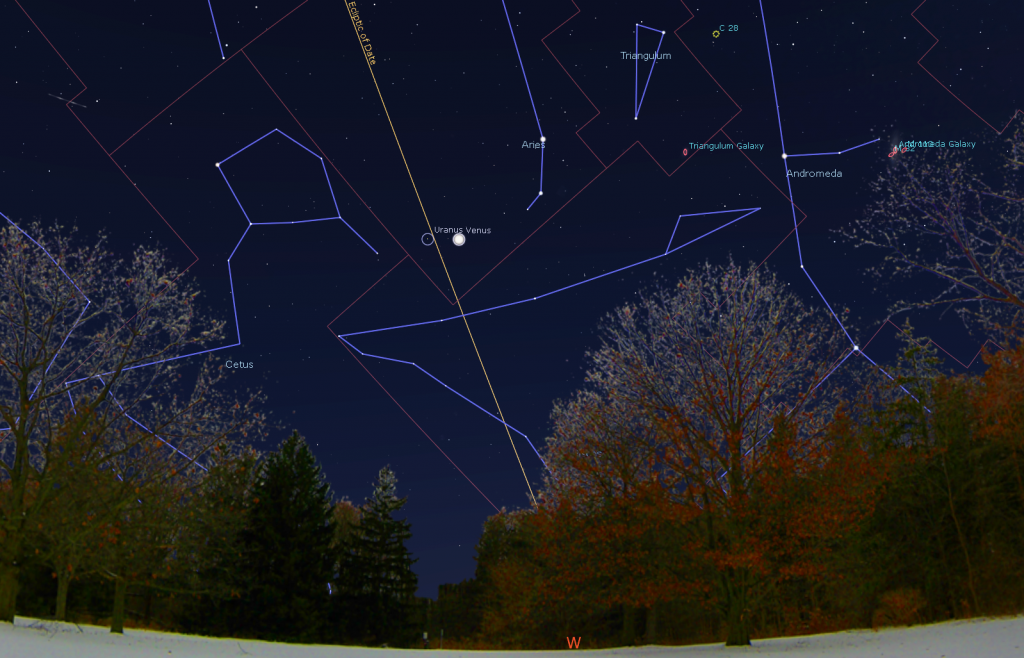
On the evenings surrounding Sunday, March 8, the faster orbital motion of Venus will carry it past comparatively dim and blue-green coloured Uranus. At closest approach on Sunday, Uranus will be positioned two finger widths to the upper right (or 2° to the celestial south) of Venus. For several nights, both planets will appear together in the field of view of binoculars and telescopes – although Uranus, which shines at magnitude +5.8, will about a thousand times fainter than Venus! This week, Uranus and Venus will set at about 11 pm local time. I recommend that you view Uranus while it’s higher, too – but after the sky has darkened. (Don’t forget that your telescope will likely flip the planets around – but binoculars will not.)
The month of March will feature some planetary fun in the southeastern pre-dawn sky. That’s where Mars, Jupiter, Saturn, and Mercury are gathered right now – in a chain along the ecliptic. Except for Mercury, those planets will be very easy to see with your unaided eyes every morning – if you have an open view to the southeast.
Reddish Mars will rise first – just before 4 am in your local time zone. Much brighter, and whiter, Jupiter will follow it at 4:30 am. Medium-bright, yellowish Saturn will rise shortly before 5 am.
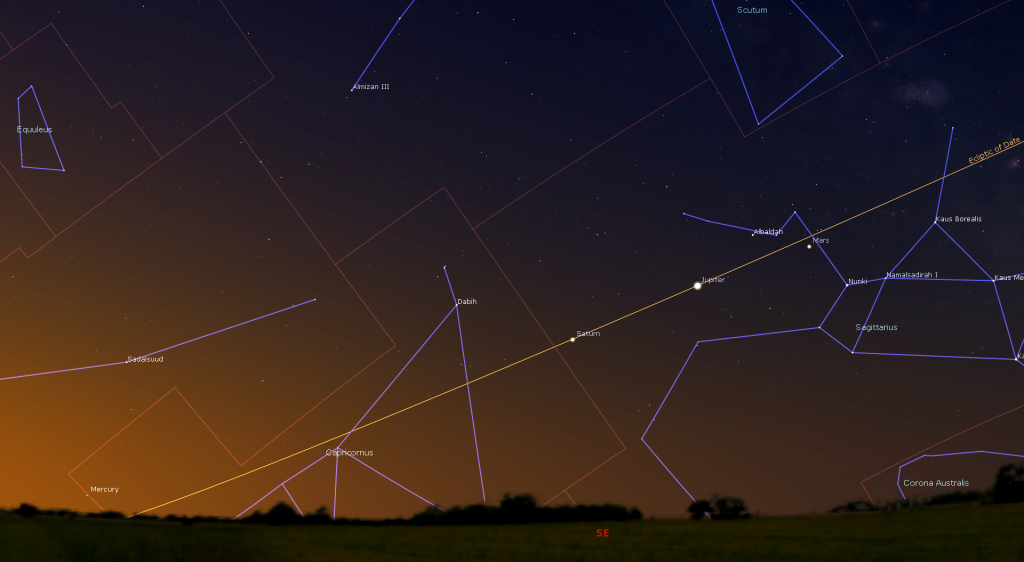
Saturn will be sitting less than a fist’s diameter to the lower left of Jupiter all week. On Monday morning, Mars will sit about a fist’s diameter to the upper right (or 9.5° to the celestial east) of Jupiter – but that separation will shrink to a palm’s width on the coming weekend. All week long, Jupiter will be easily visible until sunrise, and its Great Red Spot will be visible on Friday morning, March 6.
Speedy little Mercury will peek above the eastern horizon just before sunrise – at about 6 am local time. It will start out widely separated from the other three planets, but it will rapidly move westward towards them during the next two weeks.
I’ll post sky charts for all the observable planets here.
More Things to look at on a Moon-filled Week
Even when the moon is bright, we can still enjoy the brighter stars and the patterns they make in the sky – whether it’s a formal constellation, or some other shape you imagine.
The Winter Football asterism, also known as the Winter Hexagon and Winter Circle, is an informal pattern composed of the bright stars Sirius in Canis Major (the Big Dog), Rigel in Orion (the Hunter), Aldebaran in Taurus (the Bull), Capella in Auriga (the Charioteer), Castor and Pollux in Gemini (the Twins), and Procyon in Canis Minor (the Little Dog). After dusk, the huge shape will stand upright in the southern sky, extending from 20 degrees above the horizon to nearly overhead. The Milky Way passes vertically through it. The football is visible during evenings from mid-November to spring every year. The waxing gibbous moon will travel through the asterism from west to east, on March 2 to 4. The moon does that once every lunar month.
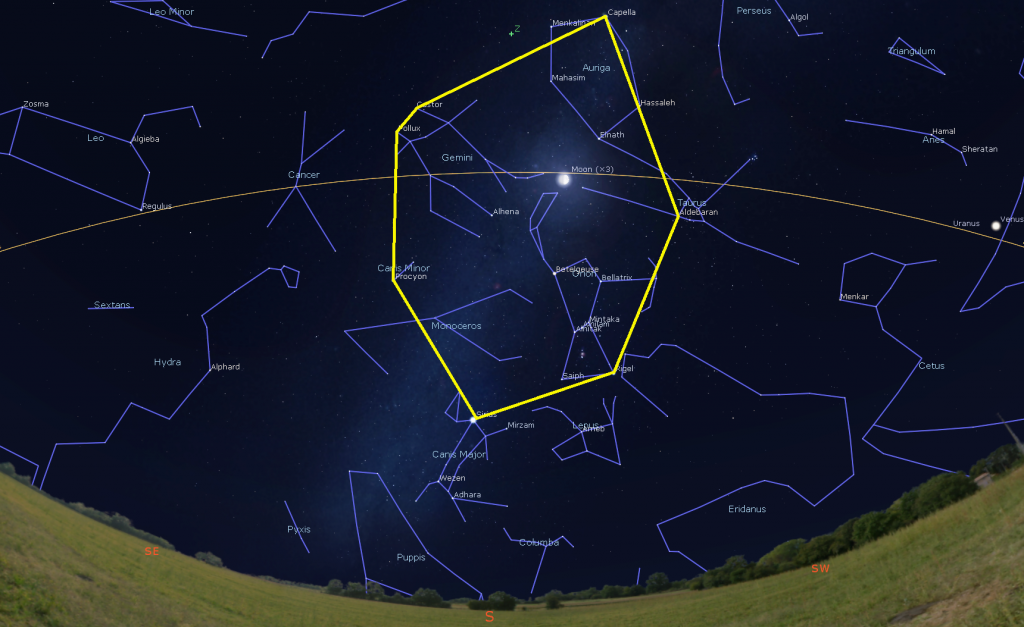
The bright star Betelgeuse marks the eastern shoulder (or armpit) of Orion. It sits a fist’s diameter above Orion’s three-starred belt. I reported that, late in 2019, that aging red supergiant star suddenly began to dim dramatically. Some people thought that this was a sign that the star was preparing to explode in a supernova. Other experts predicted that the star, long known to naturally vary in brightness over several independent time periods, might have just reached a synchronization of all those dimming effects.
It now seems that the latter situation was the case, and Betelgeuse has begun to brighten again. Take some time to look at Betelgeuse with your unaided eyes. Does it appear to be brighter than Orion’s other shoulder star Bellatrix? Is it brighter or dimmer than the belt stars Alnitak, Alnilam, and Mintaka? Or, has it recovered fully to shine as brightly as Rigel, the blue star that marks Orion’s western foot. Astronomers carefully record the brightness of stars and report them to the American Association of Variable Star Observers (AAVSO). There’s a graph of Betelgeuse’s brightness over the past three months here.
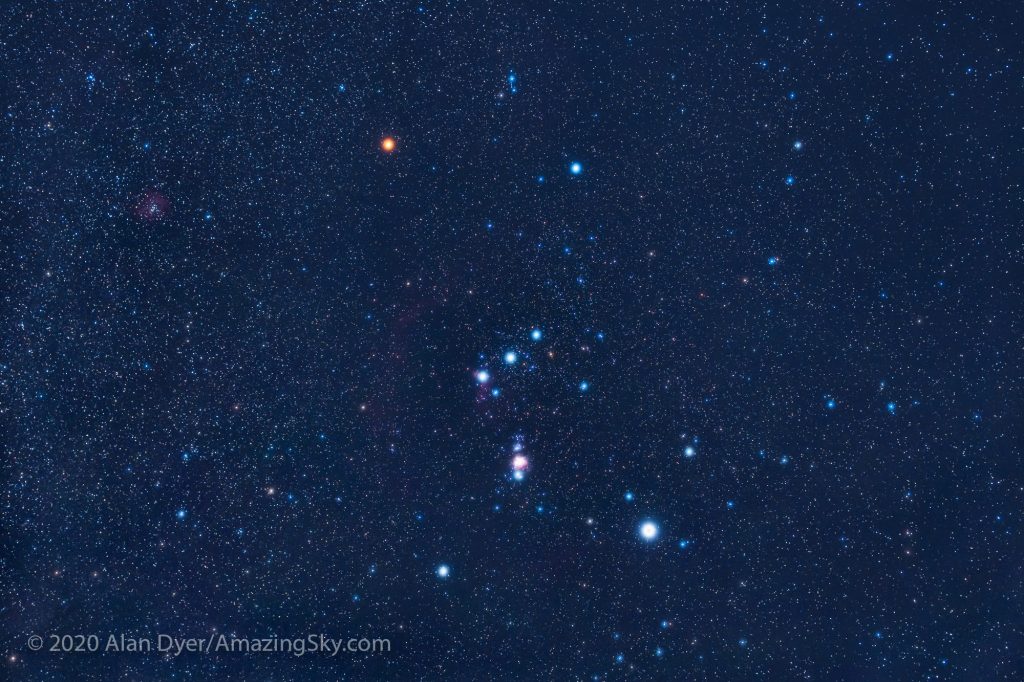
While you are noting Betelgeuse’s brightness, take a moment to check out its red colour – and the colour of the other stars I mentioned above. Can you tell that Aldebaran is orange, Capella is yellow, and that Sirius is white? Actually, Sirius has a tendency to twinkle with flashes of primary colours. I wrote about the phenomenon last week here.
Public Astro-Themed Events
If the skies are clear on Sunday evening, March 1 from 8 to 10 pm, the University of Toronto Amateur Astronomers Society (UTAAS) will hold a free, public stargazing session on the Front Campus, King’s College Circle. Details are here.
Taking advantage of the moon and bright planets in the sky this week, astronomers from RASC Toronto Centre will hold their free monthly public City Sky Star Party in Bayview Village Park (steps from the Bayview subway station), starting around 8 pm on the first clear weeknight this week (Mon through Thu only). You don’t need to be an RASC member, or own any equipment, to join them – looks through their telescopes are free! Check here for details, and check the banner on their website home page or Facebook page for the GO or NO-GO decision around 5 pm each day.
Every Monday evening, York University’s Allan I. Carswell Observatory runs an online star party – broadcasting views from four telescopes/cameras, answering viewer questions, and taking requests! Details are here. On Wednesday nights they offer free public viewing through their rooftop telescopes, including their brand new 1-metre telescope! If it’s cloudy, the astronomers give tours and presentations. Registration and details are here.
On Wednesday evening, March 4 at 7 pm, the Perimeter Institute in Waterloo will present The Quantum Revolution, a free public talk and webcast about the quantum world and computing. The speaker is Shohini Ghose, founding director of the Laurier Centre for Women in Science and President of the Canadian Association of Physicists, and TED Senior Fellow and member of the Royal Society of Canada’s College of New Scholars, Artists, and Scientists. Registration and details are here.
On Thursday, March 5, starting at 8 pm, U of T’s AstroTour will present the public lecture Unlocking Cosmic Mysteries with the Invisible Radio Universe by Hamsa Padmanabhan, a CITA Fellow at the Canadian Institute for Theoretical Astrophysics, and an Associate of the Dunlap Institute for Astronomy & Astrophysics at Toronto. Stargazing will follow (weather permitting). Details are here.
If it’s sunny on Saturday morning, March 7 from 10 am to noon, astronomers from the RASC Toronto Centre will be setting up outside the main doors of the Ontario Science Centre for Solar Observing. Come and see the Sun in detail through special equipment designed to view it safely. This is a free event (details here), but parking and admission fees inside the Science Centre will still apply. Check the RASC Toronto Centre website or their Facebook page for the Go or No-Go notification.
And if the skies are clear on Saturday evening, March 7, RASC Toronto Centre members will set up their telescopes outside on the Teluscape, in front of the Ontario Science Centre’s main doors, for a free stargazing session from 6 to 8 pm. Parking fees may apply.
This spring, spend a Sunday afternoon in the other dome at the David Dunlap Observatory! On Sunday, May 3, from 1 to 4 pm, join me in my Starlab Digital Planetarium for an interactive journey through the Universe at DDO. We’ll tour the night sky and see close-up views of galaxies, nebulas, and star clusters, view our Solar System’s planets and alien exo-planets, land on the moon, Mars – and the Sun, travel home to Earth from the edge of the Universe, hear indigenous starlore, and watch immersive fulldome movies! Ask me your burning questions, and see the answers in a planetarium setting – or sit back and soak it all in. Sessions run continuously between noon and 2 pm, and repeat from 2 to 4 pm. Ticket-holders may arrive any time during the program. The program is suitable for ages 3 and older. The Starlab planetarium is wheelchair accessible, but everyone else sits at floor level. For tickets, please use this link. Tickets for future dates will be available soon.
Keep looking up, and enjoy the sky when you do. I love questions and requests. Send me some!